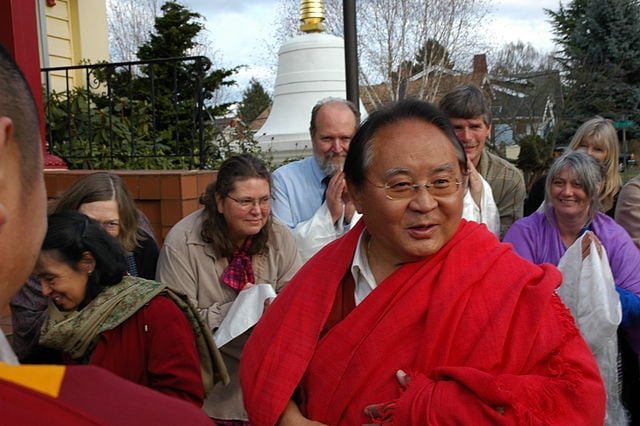Recently, one of the world’s most prominent Buddhist groups was thrown into disarray.
Its leader was accused of sexual, physical, emotional, and financial abuse by almost a dozen of his closest students. His name is Sogyal Rinpoche.
Although financial harm, physical harm, emotional torture, and so forth were amongst the allegations of the “faithful,” it was sexual abuse that the media focused on most.
This recent scandal isn’t the first for Sogyal Rinpoche, but it is by far the most well-founded and documented indictment against him. This master has weathered many storms, but this one finally sank him. He has resigned as head of Rigpa, one of the oldest and largest Tibetan Buddhist associations known in the Western world.
The scandal has elicited comments from many of the leading Tibetan Buddhist masters of our time, including His Holiness the Dalai Lama, Mingyur Rinpoche, and Matthieu Ricard—all of whom criticized Sogyal Rinpoche’s behavior in no uncertain terms. However, Dzongsar Khyentse Rinpoche, one of the most highly respected figures in Tibetan Buddhism, was ambiguous at best and condoning (with conditions) at worst. In Dzongsar Khyentse Rinpoche’s 10,000 word essay, he practically ordered his readers to read it all or nothing in order to understand his view.
This is my take as a Buddhist practitioner of 50 years—10 of which I served as a monastic.
Before beginning, I will say a word about my own view toward recognizing an enlightened master and what I saw in my own teacher that conditioned my view. My teacher, Master Hsuan Hua, remarked during a public lecture that he had never once entertained a thought of sexual desire. Our monastery, the City of 10,000 Buddhas, is situated on 400 acres in Northern California with one half designated for nuns and one half for monks. They gather in the center temple for combined ceremonies, but are otherwise never in contact. The same is true for the laymen and laywomen living there.
If monastic affairs necessitated male and female interaction, it could only be done if each party took another as a witness. On one occasion, this was violated and a monk and a nun had a casual conversation. When this was reported to the master, he didn’t say a word, but walked to the nun’s private temple, sat in a chair at the doorway, and draped a black cloth over his head to indicate he was ashamed. He sat there for three days and three nights without rising.
That said, sexual misconduct is a serious concern in the Buddhist tradition. The key argument on Sogyal Rinpoche’s behalf, according to Dzongsar Khyentse Rinpoche, that may justify his behavior is the concept of samaya,” especially as it relates to Vajrayana Buddhism. Samaya is the bond between guru and disciple, and it is a commitment to each other and trust that is a million times stronger than marriage. It, like a marriage, is a pledge formally spoken in a ritual. A disciple is expected to do anything the guru says without question and view anything the teacher says or does as “enlightened activity,” and so forth. If the student (even for an instant) doubts his guru’s motivation or abilities, it is considered a breach of samaya.
Consider how much greater the offense would be if he actually said a critical word against his guru.
What samaya holds for the disciple also holds for the guru. The guru who intentionally harms his disciple in any way—physically, sexually, emotionally, or financially—is a candidate for “Vajra Hell.”
While the Dalai Lama labeled Sogyal Rinpoche’s actions a “disgrace,” and other masters echoed similar sentiments, Dzongsar Khyentse Rinpoche infused his essay with the concept of samaya; that a “vajra” guru and disciple are bound by mutual pledges saying “anything goes” in their relationship. In other words, if the guru deems beating, demanding donations, sexual abuse, and so forth as being “skillful means” to help his disciple attain enlightenment, that action is considered permissible and cannot be questioned.
While it is supposed to be a two-way street, it seems that it is always the disciple who is called out for breaking samaya with the guru, rather than the other way around.
In this case, Dzongsar Khyentse Rinpoche seems to be arguing that the students knew what they were getting into as Vajrayana practitioners seeking various empowerments and initiations. If abuse was part and parcel of their guru/disciple relationship, they should treat everything as the guru’s enlightened activity.
Dzongsar Khyentse Rinpoche did mention, however (and importantly), that if Sogyal Rinpoche was remiss in properly warning his students of what a Vajrayana commitment entails before they made that commitment, then he would be the one who has broken his samaya to his students and would pay the price in Vajra Hell.
I was struck more by what Dzongsar Khyentse Rinpoche failed to question in a guru/disciple relationship than by what he said in his 10,000 word essay. While he did mention that a master should be qualified to give initiation, and expressed some doubt as to whether Sogyal Rinpoche’s fame as a master was justified, he didn’t make it a main point. And it should have been.
By definition, a “master” has transcended the “realm of desire.” If we are governed or controlled by desire, we are not enlightened. Breaking the bonds of desire is a stage of attaining enlightenment, and not even the final one. This stage and the others are outlined clearly in the Buddha’s word and commentaries. As I read Rinpoche’s essay, I wondered if Sogyal Rinpoche had the desire to commit these acts or not. But the the point was never mentioned.
If a so-called master has animal instincts like I do—no matter how eloquent and intelligent he may be—can he be my teacher?
To my mind, the more important question to ask regarding Sogyal Rinpoche’s actions is not related to samaya, but rather his motivation for committing the alleged offenses. Was he motivated by sexual desire when he “raped” his disciples? Was he greedy for wealth and power when he sought donations? Or was he free of all desire and actually using “enlightened activity” to benefit his students? This has been the case in many guru/disciple relationships, and many biographies document these relationships well—most notably in the life of Milarepa and Marpa.
It is known that masters who have broken samaya through desire for sex, wealth, food, power, fame, and so forth can be humble monks or outrageous mad men—whichever they deem beneficial for their students. The Vimalakirti Sutra, for example, chronicles Vimalakirti visiting whore houses and bars and using his “enlightened activity” there to benefit others. Vimalakirti was free of desire and could therefore do as he pleased.
Were Sogyal Rinpoche’s actions motivated by love and compassion—or lust? That is the question we should be asking ourselves.
Before any commitment to any master is made, that master should be properly determined as free of all selfish cravings—only then may he/she be considered worthy of our samaya. Needless to say, a lot rests on the thoroughness of our investigation. We don’t want to take pledges with a teacher and find ourselves years down the line writing indictments like the ones we are seeing now against Sogyal Rinpoche.
What we see unfolding in the Rigpa affair should be a lesson to all of us to thoroughly examine a teacher’s qualifications before committing to him.
H.H. Dalai Lama suggests that when we first entertain the idea of committing to a guru, before we attend any initiations as a disciple, we should go to initiations and discourses in the capacity of a “student” and not as a disciple. Only when we are thoroughly convinced of the guru’s qualities as a teacher, should we move into a closer relationship.
~
Author: Richard Josephson
Image: Wikimedia Commons
Editor: Danielle Beutell
Copy Editor: Travis May
Social Editor: Travis May









Read 0 comments and reply